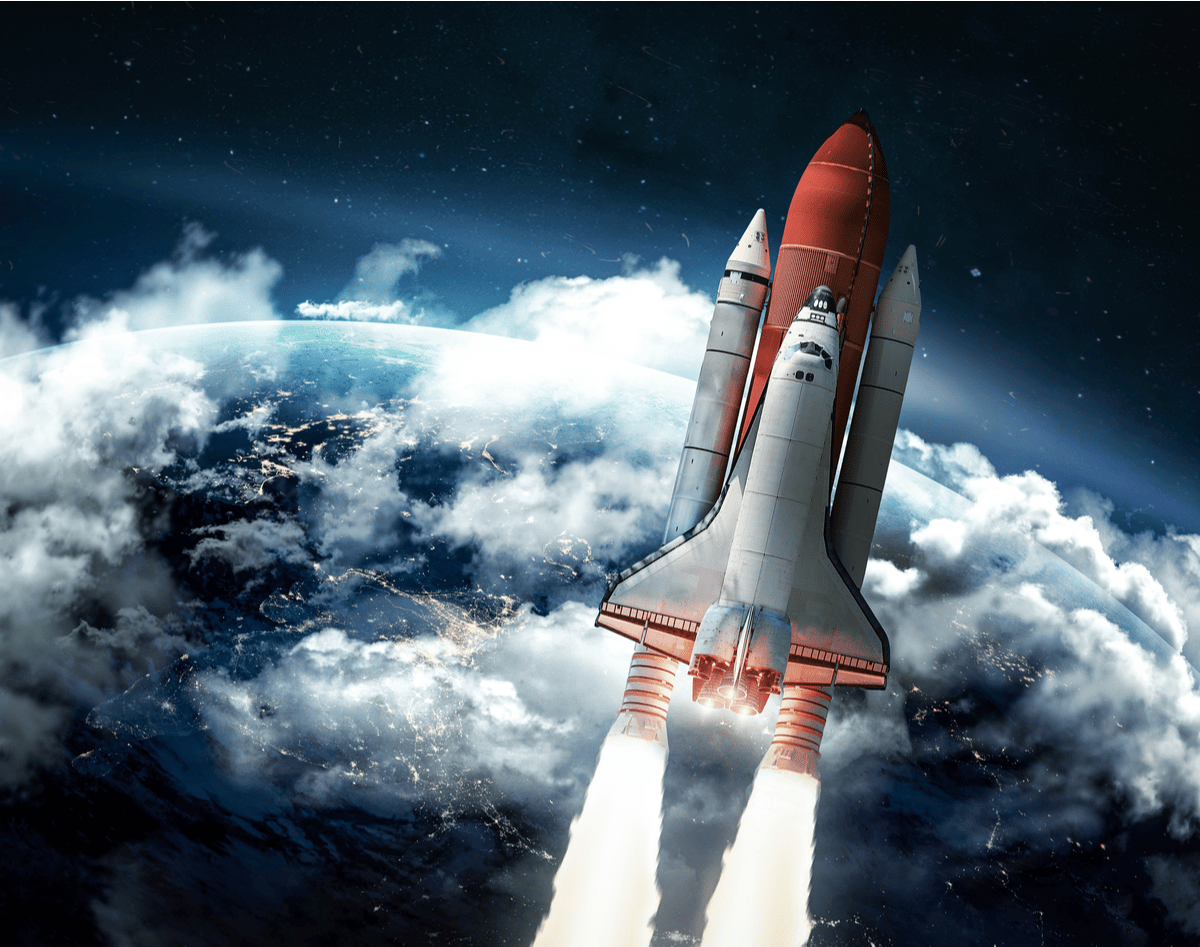

By Elainna Ciaramella
“In the modern era, we’ve had the Industrial Revolution, the Information Age, and soon, the Space Age. Space is the next industry to totally change the world,” says Brian McCann, CEO of Intergalactic (formerly known as Airborne ECS, a re-brand covered by TechBuzz), a St. George-based aerospace company run by innovation crusaders focused on removing heat barriers in space and sky.
The key question Intergalactic poses to the aerospace industry: “What could you do if heat wasn’t a limiting factor?”
 According to McCann, analysts expect the space market to triple to $1.4 trillion by 2030 and eclipse $3 trillion by mid-century, noting how these may be conservative estimates given that many analysts expect Elon Musk’s SpaceX to become the world’s most valuable company this decade.
According to McCann, analysts expect the space market to triple to $1.4 trillion by 2030 and eclipse $3 trillion by mid-century, noting how these may be conservative estimates given that many analysts expect Elon Musk’s SpaceX to become the world’s most valuable company this decade.
McCann says space is compelling because it opens possibilities that are fundamentally limited on Earth. For example, space mining changes the entire complexion of the geopolitics around natural resources and raw materials in the global supply chain.
“Satellite constellations are changing how we track extreme weather, monitor cargo shipments on the oceans, and even connect to the internet. These are just a few examples of the myriad of ways commercializing space promises to improve the human experience on Earth,” says McCann.
Intergalactic’s plan was always to expand into the space market, explains McCann. “Defense aerospace is a valuable beachhead because the performance requirements are intense and the requirements to test and qualify your hardware are unforgiving. The capabilities we’ve developed serving the defense sector offer important benefits to the commercial space sector.”
McCann says that at the top of the emerging space market—companies like SpaceX, Blue Origin, Rocket Lab, Astra, Firefly, and Relativity Space are pushing the envelope on innovation. “The trouble is, these companies are limited by an aerospace supply chain that hasn’t seen meaningful innovation in decades.” The basic physics get very difficult when you’re trying to do things like land a reusable rocket back on the pad it launched from and send human crews to Mars, he says.
“We can’t rely on the systems and solutions that were designed during the first space race and incrementally improved in the ensuing decades. A whole host of constraining problems, like thermal regulation, need to be re-evaluated with new solutions designed and brought to market. That’s where we have an enormous opportunity to provide enabling technologies to innovators in the space sector.”
Specifically, says McCann, if you look at the keys to colonizing Mars, we know we cannot take 18 months to get there. We haven’t figured out yet how to keep humans in space that long without lasting health implications. So, we need to get there faster, a lot faster, he says. This means we need better efficiency across all critical flight systems.
“The more electronics we pack into these systems, the more heat becomes a constraining problem. The same goes for increasing density and power of mechanical components. Standard thermal management can’t handle those dramatically increased heat loads—Intergalactic can.”
Intergalactic deliberately goes outside aerospace for top talent
According to McCann, their industry is being disrupted so if they anchor too hard on “best practices,” they’ll build a company that’s not relevant in 5-10 years. “We need to get outside perspectives from people who’ve built companies in emerging markets facing disruptive pressures,” he says.
“That’s why I’ve included people in my C-suite like Gary Stone, who’s operated and launched startups in regulated markets, and Brad Plothow, who spent the last decade working with venture-backed tech companies in Silicon Slopes and Silicon Valley.”
Intergalactic wants to blend the perspective of industry veterans and people who’ve found success in other markets. They believe it’s a huge advantage for them because none of their competitors are doing it, he explained.
Intergalactic resonates with companies like SpaceX and Blue Origin because they put extreme value on innovation and they see the world the way they do—through the lens of the “innovation imperative” that’s shaking up the entire aerospace industry, he says. “We also think like them in terms of our corporate personality and aesthetic. Our brand is a little edgy and irreverent, which is by design.”
Space opens economic possibilities beyond our wildest imagination
McCann says there are dozens of use cases in space that could become markets valued in the tens or hundreds of billions in the next decade or so. One example he gave is how the pandemic has laid bare how tenuous the global supply chain is and how shifting geopolitical tensions can disrupt the U.S. economy.
“By some estimates, the microchip shortage cost the U.S. more than $100 billion in economic opportunity in 2021 alone. So, how can we mitigate that risk? First, we need access to raw materials, then we need cost-efficient means of manufacturing. The mineral mining and zero-gravity manufacturing opportunities on the moon and in orbit are incredibly enticing. That’s why the U.S. and Japan are racing Russia and China to build permanent outposts on the lunar surface and in orbit.
“Space opens up economic possibilities that extend beyond travel and tourism. Communications, education, manufacturing, resource mining, and colonization partner with travel and tourism to shape what will be the largest emerging market of this generation.”
 Kevin Kerlin, vice president of operations at Intergalactic, spoke of the potential benefits of manufacturing off-planet. He said, “One of the greatest advantages is zero gravity, which provides the ideal environment for producing high purity materials such as crystals, semiconductor wafers, metallic alloys, precision coatings, and perfectly round spheres.”
Kevin Kerlin, vice president of operations at Intergalactic, spoke of the potential benefits of manufacturing off-planet. He said, “One of the greatest advantages is zero gravity, which provides the ideal environment for producing high purity materials such as crystals, semiconductor wafers, metallic alloys, precision coatings, and perfectly round spheres.”
Other possibilities, he says, include manipulating matter at the atomic level to form new materials. “Such ‘nanotechnology’ could open the door to new discoveries in the fields of molecular biology, nanomedicine, and bioengineering.”
Space as the future of reindustrialization?
According to Gary Stone, Intergalactic’s chief operating officer, the pandemic and Russian-Ukrainian conflict have shifted the global landscape both economically and geopolitically. The pandemic has added significant pressure to supply chains globally, and markets that can rapidly industrialize closer to home will have the advantage in the new global economic order, Stone explained.
“The United States, Canada, and Mexico are well-positioned in this new economic climate, resulting in significant infrastructure investment capabilities, including space. Space is not just a sexy new idea for billionaires or planting footprints and flags on the moon. Space is the future of re-industrialization post-2008 recession, post-pandemic, and post-war.”
NASA, commercial industry, as well as key geopolitical partners, like Japan, are investing in a fully operational space infrastructure extending from low earth orbit to the lunar surface. This will set the stage for a future where manufacturing in space will be central to a new economic and geopolitical order, he says.
“The centrality of space has also been illuminated by the current Russia-Ukraine conflict. The low-cost, highly accurate satellite infrastructure in space is a key reason Russia’s plan to quickly take Ukraine failed. Intelligence was gathered prior to the invasion, as well as throughout the conflict. This intelligence comes from space and is highly reliable, accurate, and low-cost. The satellite infrastructure currently in place in space is a foreshadow of things to come.”
According to Stone, Intergalactic has the right mix of leadership, highly-trained engineers, precision, innovation and fun to fit perfectly within the infrastructure deployment planned for space, including but not limited to lunar orbiting space stations, lunar mobility vehicles, lunar terrain vehicles, moon habitats, and eventual manufacturing machinery. This, he says, is due to Intergalactic’s thermal management expertise.
 "Space does not have natural stabilizing forces to keep temperatures compatible with electronics, mechanics and human life. On Earth, magnetic fields and the atmosphere stabilize temperatures within a range. In space, Intergalactic artificially acts as the magnetic field and atmosphere in relation to thermal management.”
"Space does not have natural stabilizing forces to keep temperatures compatible with electronics, mechanics and human life. On Earth, magnetic fields and the atmosphere stabilize temperatures within a range. In space, Intergalactic artificially acts as the magnetic field and atmosphere in relation to thermal management.”
In space, temperatures not only need to be managed within the range compatible with human life, but to very precisely narrowed ranges of temperature control for finely tuned instruments and equipment, says Stone. “Intergalactic is the expert in space. We have the capabilities and expertise to manage extreme temperatures in space for all components of space infrastructure from human living quarters to highly sensitive electronics. Space infrastructure is unsustainable without Intergalactic.”
Intergalactic recognizes the need for fast, innovative and executable product vision, says Stone. Intergalactic’s internal R&D shop, “Extra Super Hyper,” was specifically developed to facilitate innovation for new products necessary to build thermal management systems for the emerging space and lunar infrastructure.
“Material science and other complex sciences will be necessary to advance new space systems. Innovation requires investment and a sandbox where errors can occur safely for the purpose of quickly advancing technology. That is the essence of Extra Super Hyper. We are innovative, nimble and wildly inventive.”
Earth’s moon, a strategic stepping stone to Mars
Intergalactic’s Head of Space Systems, Ben Bryan, was a project lead on the Mars 2020 program, so he has direct experience with Mars missions and knows all the right people, according to McCann. “Most of the energy in space right now is focused on the moon and low-earth orbit, so we’re busy helping customers make those programs a reality,” says McCann.
“The moon is viewed by most industry analysts as a strategic steppingstone to Mars. Launching from the lunar surface allows us to get there much more efficiently. We’re eager to turn our sights to Mars in the not-too-distant future because the thermal barriers involved in getting human beings to the Red Planet are significant.”
McCann and his team were recently at the National Space Symposium, held annually in Colorado Springs. McCann has been attending for the last decade or so and he’s never felt so much excitement and energy among exhibitors as he did this year. “And all of them wanted to talk to us because they are all dealing with advanced thermal issues,” says McCann.
Intergalactic’s total addressable market includes every traditional player in the space market. Lockheed Martin, Northrop Grumman, Raytheon, Boeing, Sierra Nevada/Sierra Space, L3H, and General Atomics are a few of the traditional military companies who need their services. “As far as the newer, emerging companies are concerned, SpaceX, Blue Origin, Rocket Lab, Astra, Relativity Space, Firefly, and many others also need us.”
Intergalactic hopes to inspire the next generation to go to engineering school or learn about science and get excited about space and come intern for them. As such, they offer several internship positions each semester to provide students with real-world experience to help round out their education and resumes.
Contact Intergalactic for more information.
 Elainna Ciaramella is a business journalist and hopelessly devoted storyteller living in St. George, Utah. She has interviewed business owners, researchers, CEOs, and C-suite executives from all over the country. Her curiosity is endless and she is constantly seeking information that will intrigue and inspire readers.
Elainna Ciaramella is a business journalist and hopelessly devoted storyteller living in St. George, Utah. She has interviewed business owners, researchers, CEOs, and C-suite executives from all over the country. Her curiosity is endless and she is constantly seeking information that will intrigue and inspire readers.

